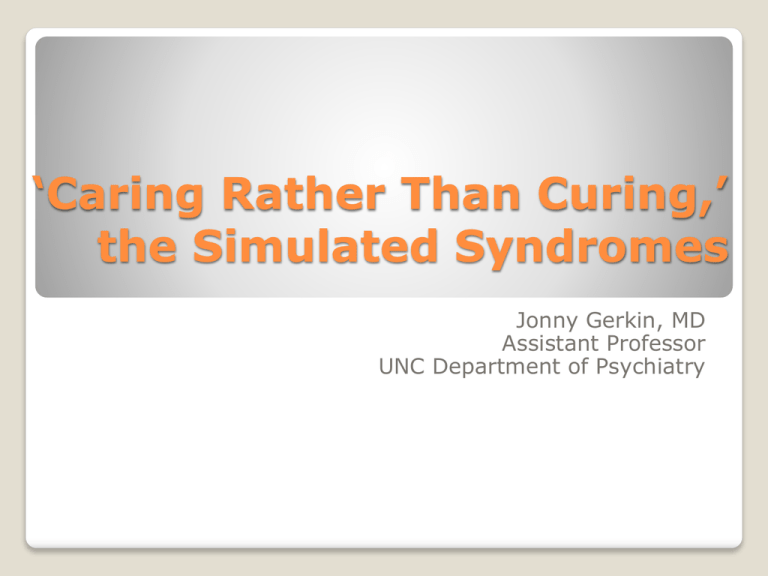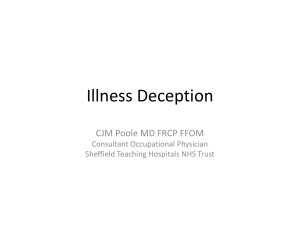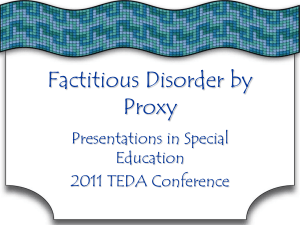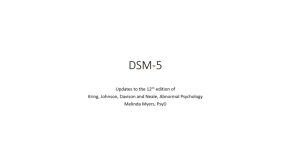
‘Caring Rather Than Curing,’
the Simulated Syndromes
Jonny Gerkin, MD
Assistant Professor
UNC Department of Psychiatry
What are we really talking about?
Somatoform Disorders, Factitious
Disorders and Malingering
SOME VOCABULARY
◦
◦
◦
◦
◦
◦
◦
Unconscious
Conscious
Primary gain
Secondary gain
Sick role
Somatization
Simulation
Prepare to be bored!.. briefly
Unconscious
◦ The division of the mind in psychoanalytic theory containing elements
of psychic makeup, such as memories or repressed desires, that are
not subject to conscious perception or control but that often affect
conscious thoughts and behavior.
Conscious
◦ In psychoanalysis, the component of waking awareness perceptible by
a person at any given instant; consciousness.
Primary
gain
◦ The direct alleviation of anxiety by a defense mechanism; the
relief from emotional conflict or tension provided by neurotic
symptoms or illness. The "gain" may not be particularly evident
to an outside observer.
Secondary
gain
◦ The external advantage derived from an illness, such as rest,
gifts, personal attention, release from responsibility, and
disability benefits. If he/she is deliberately exaggerating
symptoms for personal gain, then he/she is malingering.
However, secondary gain may simply be an unconscious
psychological component of symptoms and other personalities.
Sick role
◦ A term used in medical sociology concerning
the social aspects of falling ill and the
privileges and obligations that accompany
it…being sick means that the sufferer enters a
role of 'sanctioned deviance.‘ i.e., they get to
skip work!
Sick Role,
not to be
confused
with Rollin’
Somatization
◦ A process describe as the tendency of certain
patients to experience and communicate
psychological and interpersonal problems in the
form of somatic distress and medically
unexplained (or out of proportion) symptoms
for which they seek medical help.
◦ It is vital for medical practitioners to recognize
somatization as a MASKED PRESENTATION
OF PSYCHIATRIC ILLNESS.
Somatization ≠ Somatoform D/O
Simulation
◦ In this context we are referring to the
production of symptoms. Whether it is
conscious or unconscious, volitional or nonvolitional, is secondary.
Production Motivation
Predom
Gain
Somatization Unconscious Unconscious
(Somatoform
D/O’s)
Primary
Factitious
D/O’s
Malingering
Conscious
Unconscious
Primary
Conscious
Conscious
Secondary
All of the above have some elements of
SIMULATION and DECEPTION & elements of
primary and secondary gain - each existing on
a continuum & varying over time and context.
Somatoform disorders include:
◦
◦
◦
◦
◦
◦
◦
Somatization Disorder
Undifferentiated Somatoform Disorder
Conversion Disorder
Pain Disorder
Hypochondriasis
Body Dysmorphic Disorder
Somatoform Disorder NOS
Common feature = unexplained
physical symptom not intentionally
produced
There are major difficulties in the clinical
application of somatoform disorders…
Spinal Cord Astrocytoma Mistaken for
Conversion Disorder…
Catatonia mistaken for Conversion…
◦ ‘a diagnosis of conversion disorder must remain a
provisional hypothesis that has to be periodically
reevaluated.’
Excluding a medical cause for
symptoms is problematic
Somatization Disorder:
There is a history of many physical complaints,
beginning before the age of 30.
Each of the following criteria must have been met:
Four pain symptoms (4 Pain)
Two gastrointestinal symptoms (2 Stomachs)
One sexual symptom (1 Sex)
One pseudoneurologic symptom (Convert)
Each symptom cannot be fully explained by a known
medical condition, or, if there is a demonstrated
medical condition, the impairment is in excess of
what would be expected.
Mnemonic: Recipe 4 Pain: Convert
2 stomachs to 1 sex
Undifferentiated Somatoform Disorder
◦ One or more physical complaints cannot be fully
explained by medical condition/substances, lasting
6 or more months, do not fulfill criteria for
Somatization d/o – generally similar characteristics
just fewer symptoms
Somatoform D/O NOS
Pseudocyesis, non-psychotic hypochondriacal
symptoms < 6 months, unexplained physical
symptoms < 6months
Differ from Conversion b/c
symptoms physical and time
Conversion Disorder
◦ Neurological (voluntary motor or sensory) symptoms or
deficits that are associated with psychological factors
that cause significant distress
◦ Symptoms or deficits are not intentionally produced
◦ Typically begin abruptly and dramatically
◦ La belle indifference (not pathognomonic, no prognostic
value) – not distressed
◦ Psychodynamic views – primary gain, e.g. a conflict
about aggression expressed by paralyzed arm
◦ Most patients show rapid response to treatment
◦ Pseudosz, amnesia, tremor more likely to have poor
outcome – sig relationship to childhood (sexual) trauma
Pseudoseizures, paralysis, amnesia,
blindness, ataxia, deafness…
◦ Pain Disorder
The primary criteria require that pain be the
primary complaint and that it causes significant
distress or functional impairment.
Psychological factors have important role.
Not intentionally produced.
Not better accounted for by Mood, Anxiety or
Psychotic D/O, not meet criteria for Dyspareunia
◦ Types:
Associated with Psychological Factors
Associated with both Psychological Factors and
a General Medical Condition
Pain is the most common reason a
patient presents to a physician for
evaluation.
◦ Hypochondriasis
Core feature is fear of disease or a conviction that
one has a disease despite normal physical exam
results and investigations and physician
reassurance. At least 6 months.
In clinical practice sorting out delusional from
non-delusional hypochondriasis is sometimes
difficult. Can the person consider the possibility
that the feared disease is not present?
Primary hypochondriasis appears to be chronic –
potentially better classified as a personality style
or trait, worsens with stress.
Preoccupation not better accounted for by GAD,
OCD, Panic D/O, MDE, Sep Anxiety or other
Somatoform D/O
‘Hypochondria is the only illness
that I don't have.’
◦ Body Dysmorphic Disorder
The preoccupation with an imagined defect in
appearance (if a slight anomaly is present, the
individual’s concern with it is judged to be markedly
excessive*) that is accompanied by significant distress
or impairment in social or occupational functioning.
Increasingly seen as an OCD spectrum disorder.
Delusional BDD may represent a difference in insight
rather than a distinct syndrome.
MDD is highly comorbid, OCD, social phobia, substance
use as well.
“Normal body disastisfaction” exists, duh
Anyone watch the Hills?
Clinical Vignette: The medical service
requests a consult, the pt is demanding
unnecessary trx, pain out of proportion.
◦ 28 yo SWF c/o pelvic pain, N and V requesting IV
vancomycin for her “pelvic infection.” She vaguely
describes some vaginal discharge.
◦ She is afebrile with stable vital signs otherwise.
◦ H/o unilateral oophorectomy d/t pain of ovarian
cyst and endometriosis 4 months prior. Post-op
course was “complicated” by soft tissue infection
requiring multiple courses of vancomycin.
Wait there’s more…
The surgical wound is now healed, but she continues to note pain in her
pelvis that she feels has only been resolved by IV vancomycin previously.
She describes being diagnosed with Fibromyalgia, low back pain, HA and
generalized large joint pains.
She endorses h/o painful intercourse, painful menses
She notes she has been evaluated in the ED too many times to count
dating back to childhood and that she has had multiple practitioners not
know what to do which has led to ‘firing’ many of them.
She does endorse a history of tumultuous interpersonal relationships,
some history of domestic violence and a childhood that was less than
nurturing.
She denies depressive or significant anxiety symptoms. She does not see
any possible relationship of her symptoms to recent psychosocial
stressors to include her male ‘roommate’ moving out. She denies
substance abuse history.
Lab studies unremarkable.
That’s probably enough info…
Differential anyone?
◦ Complications of her multiple surgeries, such
as adhesions, abscess or other infectious
etiologies or autoimmune condition
◦ Substance abuse
◦ Factitious disorder
◦ Malingering
Where’s the significant secondary gain??
Somatization Disorder
Remember - Recipe 4 Pain: Convert
2 stomachs to 1 sex
Clinical Vignette: The medical service
requests a consult, the pt is demanding
unnecessary trx, pain out of proportion.
◦ 28 yo SWF c/o pelvic pain, N and V requesting IV
vancomycin for her “pelvic infection.” She vaguely
describes some vaginal discharge.
◦ She is afebrile with stable vital signs otherwise.
◦ H/o unilateral oophorectomy d/t pain of ovarian
cyst and endometriosis 4 months prior. Post-op
course was “complicated” by soft tissue infection
requiring multiple courses of vancomycin.
Wait there’s more…
The surgical wound is now healed, but she continues to note pain in her
pelvis that she feels has only been resolved by IV vancomycin previously.
She describes being diagnosed with Fibromyalgia, low back pain, HA and
generalized large joint pains.
She endorses h/o painful intercourse, painful menses.
She notes she has been evaluated in the ED too many times to count
dating back to childhood and that she has had multiple practitioners not
know what to do which has led to ‘firing’ many of them.
She does endorse a history of tumultuous interpersonal relationships,
some history of domestic violence and a childhood that was less than
nurturing.
She denies depressive or significant anxiety symptoms. She does not see
any possible relationship of her symptoms to recent psychosocial
stressors to include her male ‘roommate’ moving out. She denies
substance abuse history.
Lab studies unremarkable.
Recipe 4 pain: Convert 2 Stomachs
to 1 Sex
Management..
Limit setting and caring rather
than curing…
Recommended potential management
approaches:
◦ 1) Reattribution approach – linking symptoms
to psychological stressors. Good for those with
some insight, primary care settings.
◦ 2) Psychotherapeutic - focus upon trusting
relationship, persistent somatizers.
◦ 3) Directive – interventions framed in medical
model, hostile patients who deny psychological
or social factors in their symptomatology.
Evidence suggests the best choice for
most patients is management by their
PCP in consultation with a shrink.
Exercise, PT
Relaxation, Meditation, Hypnotherapy
Behavioral (Exposure for Hypochondriasis)
Suggestion and reassurance (emphasizing
lack of serious illness diagnoses and
likelihood of improvement through activity)
CBT (may be preferred for Hypochondriasis,
Somatization)
Dynamic, Group, Family Psychotherapies
Medications (target comorbidities,
antidepressants, SSRI/TCA’s primarily)
Avoid explanations that are heard as,
“It’s all in your head,” duh
Deception Syndromes…
Deception Syndromes
◦ Factitious Disorder
NOS (Proxy types here)
Predominantly physical signs/sxs
Predominantly psychological signs/sxs
Combined
◦ Malingering
Less a diagnosis than a socially unacceptable behavior
with legal ramifications – assigned a V code
“Just because I’m faking it doesn’t
mean I ain’t sick.”
Factitious Disorder (common - physical)
◦ Intentional production or feigning of physical
signs/sxs, behaviors are surreptitious
(stealthy)
◦ Motivation for the behavior is to assume sick
role (unconscious)
◦ External incentives for the behavior or
improving physical well being are absent
◦ No aliases generally or travel from hospital
system to system
Common risk factors: F, single,
30’s, prior health care work,
cluster B PD w/Borderline fx.
Factitious Disorder (Munchausen’s)
◦ Same criteria with self-induction of disease, but
more pervasive with use of aliases while
‘hospital hopping,’ & pseudologia fantastica
(pathological lying – grandiose storytelling)
◦ Munchausen’s by Internet? Seriously? Yup,
DSM-V
Common risk factors: M, single,
40’s, Cluster B PD w/ASPD fx
Among the most common presentations
of self induced illness have been chest
pain, endocrine disorders, coagulopathies,
infections and neurological symptoms.
Diagnostic clues include Low C-peptide,
dissociation of fever and pulse, laxative in
stool, high urinary K (diuretics), serum
assays for anticoag, etc., low serum
thyroglobulin
But what about feigned
psychological symptoms?...
Factitious Disorder Primarily Psychological..
Majority of factitious disorders describe physical
symptoms alone.
Factitious psychological symptoms are generally
in association with either authentic or fabricated
physical symptoms
Ganser’s syndrome – approximate answers,
closely related to factitious, feigning dementia
One of my patients as a resident
was a former Duke and Syracuse
Basketball player & CEO of a drug
company, who suffered with
“anxiety,” though he never
accepted prescriptions for the
medications he was “taking” and
internet searches never revealed
any evidence and he was only in
his early 30’s.
Proposed motivations for factitious
disorder:
◦
◦
◦
◦
◦
Need to be center of attention
Longing to be cared for
Maladaptive reaction to loss or separation
Anger at physicians or displaced onto them
Pleasure derived from deceiving others
(“duping delight”)
So how do we manage this stuff?
Management and Treatment
Invasive/risky diagnostic and
treatment procedures should be
based on objective evidence only.
◦ Indirect confrontation or risk hostility,
departure AMA, threats of law suits
Ex: ‘Some patients may do something to
themselves as a way of seeking help…’
◦ Treat comorbid psychiatric issues (Depression,
PD, Anxiety, Substance abuse) with meds and
psychotherapy.
◦ Supportive Psychotherapy may allow for
relationship not contingent upon new physical
symptoms
Factitious Disorder by Proxy – actually
covered by Factitious NOS per DSM-IV
◦ Also known as Munchausen’s by Proxy
Parents (usually mom) who have
induced disease in their children.
Differential for Munchausen by Proxy:
◦ Pediatric Somatization Syndromes
◦ Somatoform Disorder by proxy (parent’s
anxiety projected onto child)
◦ Infanticide/Murder
◦ Psychosis in parent
◦ Child abuse (garden variety)
◦ Factitious behavior initiated by child
◦ Malingering by child (school rejection)
◦ Unrecognized physical disease
Blended form of the condition in which child
self-produces symptoms w/aid of parent
Angel of Death Syndrome
◦ Hospital Epidemics of Factitious Disorder by
Proxy – better described as serial murder
Orville Lynn Majors, Clinton, Indiana, at least
130 murders
Richard Angelo, Long Island, New York, at least
10 murders
Michael Swango, New York, at least 4 murders
Dr. Shipman one of the world's most prolific serial
killers, claiming at least 215 victims in Britain.
Genene Jones, Texas, at least 20 murders
Efren Saldivar, California, at least 6 murders
Beverley Allitt, Britain, at least 4 murders
Malingering
◦ By definition – motivated by specific,
recognizable external incentives to produce,
exaggerate or simulate physical or
psychological illness
Hoover’s sign..but what’s the
motivation?
Malingering
◦ Embellishment of previous or concurrent illness
is most commonly encountered
◦ Symptoms tend to disappear when the person
obtains the desired goal or is confronted with
irrefutable evidence – though not always
◦ REMINDER: more of an accusation of external
motives than a psychiatric diagnosis
◦ HOWEVER: presence of secondary gains are
NOT evidence of malingering per se.
Specific neuropsych testing can
occasionally be useful.
Rule out malingering in…
◦ Patients on disability.
◦ Patients involved in litigation related to a
psychiatric condition.
◦ Patients seeking a prescription for a controlled
substance during the initial interview.
Story too perfect, too vague,
nothing works, heard about this
medication Xanax from a friend…
CONTINUUM
Conversion
Malingering
opposite poles of purely unconscious and
purely conscious motivation
Difficult at any given moment to know
where the patient is on this continuum
Pt’s with somatoform d/o’s are generally
consistent in their symptom presentation
regardless of audience/observation
The Paralyzed Paralegal
35yo woman, no
significant med hx
Presents to ER with
hemiparesis
Workup (MRI, EKG,
Carotid dopplers,
Echo) negative
Family history:
Mother w/CVA last
year
Onset of symptoms
after discovering
husband’s
extramarital affair
The Anxious Accountant
35yo man
5th primary care
visit this month
Complains of mild
headache, worries
that he has brain
tumor
Neuro exam: wnl
CT head: negative
Pt still worries that
he has cancer
The Anguished Angler
52yo man with several
year history of LBP,
persistent
History of HTN, some
alcohol
Started after job loss, has
not returned to work
Does not participate in
activities due to pain
Multiple MRIs unrevealing
of source
PT, OTC analgesics of little
benefit; opiate analgesics
transiently relieving
The Plasticized Pop Star
48yo man
Presents to plastic
surgeon
complaining of
nose deformity
History of multiple
prior cosmetic
procedures
Embarrassed by
appearance,
agoraphobic
The Anemic Aide
31 yo single female
surgical nurse aide
Refractory and
poorly characterized
anemia
Recent break up
with surgery
resident
Found with extra
butterfly needles on
her person at work
The Fatigued Farmer
58 yo man whose
farm is failing
No sequelae of
chemical exposure
on repeated
exhaustive medical
evaluations
Pursuing disability
Litigation against
chemical fertilizer
company
Remember that we cannot cure
unexplained illness, but we can
care for those afflicted by
them….which generally helps.
Levenson, James, and American Publishing. The American
Psychiatric Publishing textbook of psychosomatic
medicine. Arlington, VA: Amer Psychiatric Pub Inc,
2005. 271-309. Print.
The Psychiatric Interview, Practical Guides in Psychiatry.
'Ed'. Daniel J Carlat. Newburyport, MA: Lippincott
Wiliiams & Wilkins, 2005. Print.
References
Thanks for your attention!










